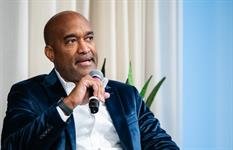
Taylor Swift and Travis Kelce said yes recently — and in that moment, so did brands chasing the spotlight.
Erica Williams is founder of BoldVision PR.
From Olipop to American Eagle, brands flipped the love story into a strategic revenue opportunity, centered on relatable branding and consumer trust.
OLIPOP offered customers a 13% discount code on any new or existing subscription order in an Instagram post, accompanied by engagement-themed soda graphics.
American Eagle also joined in, announcing their partnership with Travis Kelce’s sportswear and lifestyle brand Tru Kolors for a limited-edition collection one day after the engagement announcement.
Other brands simply used the moment to promote their products or increase audience engagement by aligning themselves with the trending topic.
Whether companies participated in the conversation by adding tangible value or just sharing fans’ excitement, one thing is clear: audience engagement is still a goldmine for trust-building, but now consumers are demanding creativity.
Today’s consumers expect brands to connect interactions to value. They are demanding that brands be authentic and customer-centric as a rule of alignment, not a gimmick.
There is a fine line between leveraging a moment and bandwagoning, but with the right strategy, it can be highly effective and foster a positive brand image.
The first step is to assess how you can add value to stand out and avoid bandwagoning. As we know, it’s expected that brands jump on trends, but it’s how they do it that counts.
For example, Poppi congratulated the couple on their engagement and, similar to Olipop, shared engagement-themed soda graphics to accompany their Instagram caption. However, there was no substantial value added beyond emotional appeal. This made Poppi come across as just another brand trying to attract attention without any real intention behind it.
The apparent brand-off between Olipop and Poppi symbolizes what trust-building looks like in real time. Both brands demonstrated that they’re aligned with their audience’s interests, which is key to trust-building; however, Olipop emphasized that it takes more than language to foster trust — it also takes strategic action that uses engagement to a brand’s advantage.
This shows that it is not enough to speak consumers’ language; you must reveal that you understand through your services and products. Transitioning from emotional appeal to service alignment is crucial for not only building trust and gaining a competitive edge but also establishing long-term credibility.
The second step is highlighting your unique perspective and expertise. Taylor Swift’s engagement dress, made by Ralph Lauren, sold out within minutes of the engagement announcement. That moment didn’t just showcase star power — it reinforced the brand’s ability to merge timeless design with cultural relevance, proving that owning your expertise and what makes your brand unique is a significant ROI source that will naturally draw attention and boost credibility.
As PR pros, to help clients stand out, we must not jump on every trend, but prioritize the trends that seamlessly fit client objectives and enable them to shine organically — alignment is the difference between strategy and opportunism.
The third step and final step is leveraging relevant partnerships and collaborations. Travis Kelce’s partnership with American Eagle wasn’t random. It was an effective and timely cross-branding strategy, enabling both parties to benefit from each other’s consumer base. It also allowed American Eagle to continue increasing its revenue and stock prices. This emphasizes that it’s not just about working with other brands; it’s about timing, effective financial planning and goal measurement.
Contrary to some perspectives, Travis and Taylor’s engagement was not a PR stunt. It was a strategic means of killing two birds with one stone: allowing fans to share their milestone while using their star power to increase their cultural capital and financial positioning.
As PR pros, we must be intentional with our partnerships and not only focus on brand fit, but also on long-term objectives. We must assess how collaborations align with company values, audience expectations, demand, and trust-building.
Tomorrow’s successful brands aren’t just tossing out a congratulatory post — they’re turning their engagement into social currency that compounds into lasting value and trust. If the future Mr. and Mrs. Kelce’s engagement has taught us anything, it’s this: anyone can embrace a trend, but the brands that win are the ones that transform cultural moments into long-term equity.
The post Wins and misses from the Swift-Kelce engagement social scramble appeared first on PR Daily.













